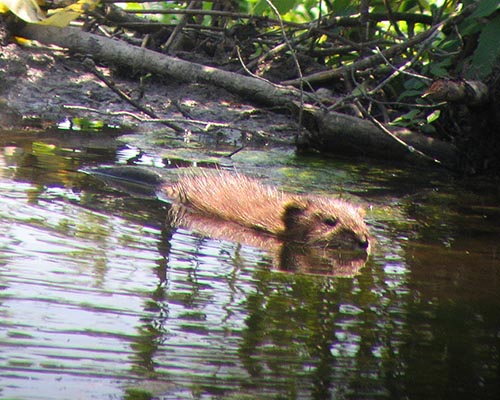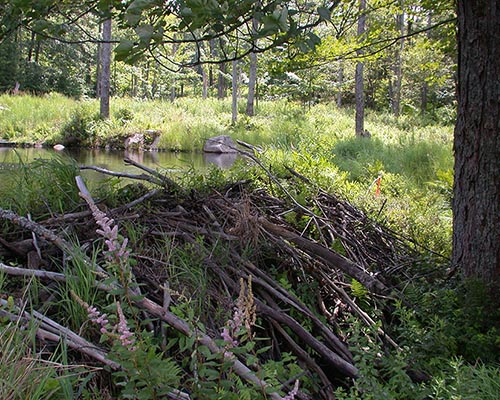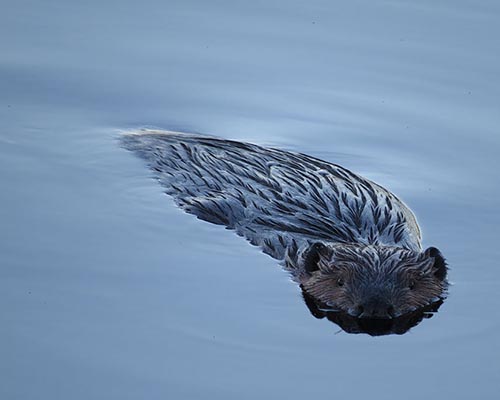This station is about a species that you probably won’t see from the Waldbauer trail, and yet you see its effects everywhere you look in the Adirondacks.
The North American beaver (Castor canadensis) is one of two beaver species in the world; the other is in Eurasia. It is the largest rodent in North America and it has many remarkable traits. It provides an excellent example to illustrate what ecologists call a niche. A niche is the lifestyle of an organism: where it lives and what it eats, but also things such as how it avoids predators or what other species it depends on. The beaver has a specialized niche. It lives in ponds or small lakes and eats vegetation. It is well adapted to its niche. It is an excellent swimmer, with webbed hind feet and a broad, flat tail. It can seal its nose and ears against water, and it sees well underwater. Its thick fur, waterproofed with glandular secretions, insulates it; a thick layer of fat also helps. It can stay underwater for up to 15 minutes. It is also well adapted to eating vegetation, with un-webbed front feet for grasping and manipulating plants and long, strong front teeth for gnawing through branches and even tree trunks.
Beavers are attracted to the sound of running water and instinctively pile branches and mud on top of the sound. The end result is a beaver dam. A pond or small lake fills up behind the dam and that is where the beaver then lives. This is called niche construction — the beaver doesn’t just occupy its ecological niche, it actively constructs it. Beavers may engineer a hollow portion within a dam to use as a lodge or build a separate lodge in the pond, using the surrounding water as protection from predators. The only entrance is underwater. The beaver gnaws out the entrance and interior after the lodge is otherwise complete. This gives it a warm home in winter. The inside is sealed with plastered mud to make it warmer and also protect it from predators. The dam even provides the beaver with sources of food. The forest flooded by the dam is a safe place for the beaver to forage. It will eat the cattails and other plants that grow in the still water of its pond. In the fall, it will even store branches underwater that it can eat in the winter, safe below the ice surface. Beaver lodges can be seen by boat along the Marion River, in most bays of Raquette Lake and around the bridge in the village of Raquette Lake.
And that is not the end of the story. Beavers are also what ecologists call ecosystem engineers. They don’t just construct a niche for themselves; they create an entire ecosystem for many other species. Their ponds provide habitat for fish, aquatic plants, insects, mammals, amphibians and birds. Tens of thousands of ducks are hatched and reared in beaver ponds each year in New York. Two-thirds of the wetlands in the Adirondacks were formed by beavers. Ponder that fact, and you will realize just how essential beavers are. For this reason, beavers are also called keystone species. They increase the biodiversity in their habitat. If they disappear, many other species will disappear too, just as an arch will collapse if the keystone at its top is removed.
You are much more likely to see a beaver swimming in its pond than walking on dry land. Sometimes its broad, flat tail will be visible. Often, however, its tail is underwater, and then it can be hard to tell it from other animals such as mink or otter except by its size. If a swimming beaver notices your presence, it will often strike the surface of the water with its tail, making a loud slapping sound, and then swim underwater to its den. Indeed, this is often the first sign that a beaver is nearby, because it will often notice you before you notice it.
Beavers have suffered considerably at the hands of humanity. Extensive trapping began in the early 17th century; by the 1630s, some 80,000 beaver pelts were exported each year from the Hudson River region and western New York. As beaver became scarce here, the trappers moved west. In fact, the westward expansion of settlers into North America was substantially driven by the fur trade. By the mid-19th century the North American beaver was close to extinction. In 1895 only one colony of 5-12 beavers, located in the Adirondacks, was known in New York. Protections instituted since then have helped it recover. There are now some 55,000-75,000 beavers in the Adirondacks, but that is still about a tenth of their population prior to the arrival of Europeans.



